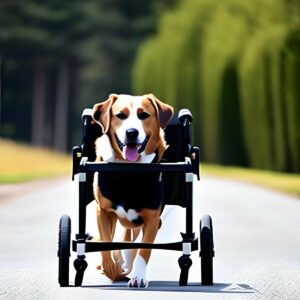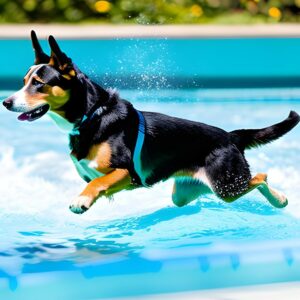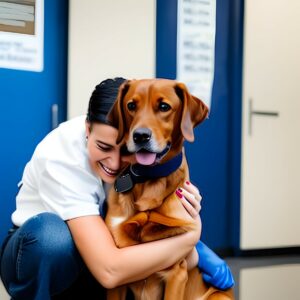Whether you’re a new pet parent to a senior dog or have had them for years, it is always a good idea to look for senior dog care tips and tricks to help your furry baby thrive at any age.
Depending on the breed, dogs are considered seniors after the 7th year of age for larger dogs and the 10th year of age for smaller breeds.
This doesn’t mean that your dog has to develop health issues, but keeping an eye on changes is always a great idea.
In this article, we’ll explore some tips to help you provide the best care for your four-legged companion and help you understand/ what to expect with an aging dog.
Let’s begin.
Senior Dog Care Tips: Table of Contents
1. Senior dog care tip: Diet adjustment

Senior dog food is designed to meet nutritional needs and often includes lower calories, higher fiber, and more easily digestible ingredients. Regardless if you are feeding specialized senior dog food or home cook, these tips will help you better understand portioning, nutrient values, and supplementation.
Here are some tips for adjusting senior dog nutrition:
Choose a high-quality senior dog food
Look for brands that have high-quality protein sources and a good blend of vitamins and minerals. In the ingredients list look for the percentage of proteins and if they are listed first.
Choose lean meats or fish and if possible look for grass-fed, aka, wild-caught.
Wet senior dog food is a great option for dogs that have some dental or digestion issues, and kibble foods are well-balanced sources for maintaining the overall health of joints, vision, and organs.
Adjust portion sizes
Senior dogs are generally less active than younger dogs and may require fewer calories. Adjusting portion sizes can help prevent weight gain, which can exacerbate joint pain and other health problems.
Consider feeding smaller, more frequent meals: Older dogs may have difficulty digesting large meals.
Exact measurements are shown on the food packaging.
Senior dogs may also experience increased or decreased appetite. One can lead to obesity and the other to malnutrition; both can then lead to more serious health issues.
This is why AAFCO delegates nutritional values that food brands should follow.
Overall, providing a well-balanced diet that meets the nutritional needs of your senior dog can help them maintain their health and quality of life in their golden years.
Home-cooked meals
Home-cooked meals can be a good option for senior dogs, as they offer more control over the ingredients and portion sizes. However, meals have to be nutritionally balanced and meet your senior dog’s specific dietary needs.
Home-cooked meals should be made with high-quality ingredients, such as:
- lean meats like chicken or turkey,
- supplemented with healthy carbohydrates, such as brown rice or sweet potatoes.
- Senior dogs may also benefit from the addition of vegetables, such as carrots or green beans, for added fiber and vitamins.
Some examples of foods:
Cooked Chicken: Lean and easily digestible, cooked chicken is an excellent source of protein for senior dogs.
Cooked Turkey: Another lean protein source, it’s also a good source of tryptophan, an amino acid that can help promote relaxation.
Sweet Potatoes: Rich in fiber, beta-carotene, and other nutrients, sweet potatoes can be a great source of carbohydrates for senior dogs.
Green Beans: Low in calories and high in fiber, green beans can be a great addition to senior dog diets.
Brown Rice: A good source of carbohydrates, brown rice can also provide senior dogs with fiber and B vitamins.
Carrots: A great source of beta-carotene, vitamin A, and fiber, carrots can be a healthy and tasty addition to senior dog meals.
Squash: Rich in vitamins A and C, as well as fiber.
There are plenty of great recipes for home-cooked meals for senior dogs, we found some delicious options here.
It’s important to avoid certain ingredients in home-cooked meals, such as:
- onions,
- garlic,
- grapes,
- chocolate,
- avocado,
- not all types of fish are safe for dogs to eat, and some types of fish can be high in mercury or other toxins. Also, fish bones can pose a choking hazard or cause gastrointestinal issues for dogs.
Working with your veterinarian can help ensure that your senior dog receives a healthy and balanced diet that supports their overall health and well-being.
Supplements
Some senior dogs may benefit from supplements such as glucosamine and chondroitin, which can help support joint health, or omega-3 fatty acids, which can help support brain function.
Note: vets will prescribe supplements based on the dog’s needs, please don’t single-handedly pick supplements. If you have concerns, talk to the vet.
2. Senior dog care tip: joint pain management

Arthritis is a common issue in senior dogs, so it’s important to supply your pet with a comfortable bed with plenty of cushioning and provide ramps or stairs if they need assistance climbing onto furniture.
It is also important to keep your senior dog active.
Low-impact activities such as swimming or walking can help to keep their joints flexible and reduce pain. If your dog is having difficulty with mobility, consider using a harness or sling to help them move around. Additionally, make sure to keep your pet’s nails trimmed to reduce the strain on their joints.
Below, we listed more tips for pain management.
3. Senior dog care tip: exercise

Exercise is still important for senior dogs, but the intensity and duration of exercise should be adjusted.
Senior dogs may tire more quickly, so if your dog is showing signs of fatigue or excessive panting, it is best to stop the activity and allow them to rest.
Here are some great exercises for you and your dog:
Short walks
Senior dogs may not be able to handle long walks, but short walks can still help keep them active and maintain their muscle tone. Start with a slow, gentle pace and gradually increase the distance as your dog’s stamina improves.
Gentle swimming
Swimming is a low-impact exercise that can be great for senior dogs, especially those with joint problems or arthritis. If you have access to a pool or a lake, try taking your dog for a swim.
Stretching
Gentle stretching can help maintain your dog’s flexibility and range of motion. Try gently stretching your dog’s limbs and massaging their muscles to help relieve tension.
Puzzle toys
Puzzle toys are a great way to stimulate your senior dog’s mind and keep them mentally sharp. Try hiding treats in a puzzle toy or scattering them around the yard to encourage your dog to sniff and search.
Tug-of-war
A great way to provide your dog with some resistance training. Just make sure to use a soft, non-toxic toy and avoid pulling too hard, especially if your dog has dental problems.
Slow, gentle fetch
Playing a slow and gentle game of fetch can help your senior dog get some exercise while also having fun. Just be sure to use a soft ball or toy and avoid throwing it too far.
Indoor playtime
If the weather is bad or your senior dog isn’t up for outdoor activities, try some indoor playtime. This can include playing with soft toys, hiding treats around the house, or even doing some basic agility exercises like jumping over low obstacles.
Senior dog exercise classes
Many pet stores and dog training facilities offer exercise classes specifically designed for senior dogs. These classes may include gentle exercises like walking, stretching, and basic obedience training.
4. Senior dog care tip: grooming

Regular stripping and brushing are important for all dogs, as it removes old fur and helps promote healthy skin and coat. But for senior dogs, many pet owners find it easier to comb their fur instead of strip it when possible.
When grooming a senior dog be gentle and patient. Senior dogs may be more sensitive to touch and may not be able to stand for long periods of time. They may also lose more fur, however, if your dog starts losing hair it is time for a vet visit.
Grooming is the perfect time to check for any lumps, bumps, or other signs of skin irritation and ticks that may need to be addressed.
5. Senior dog care tip: behavioral changes management
Behavioral changes such as aggression or barking more than usual can be common signs of discomfort in elderly dogs. These behaviors are usually a sign of distress and should be addressed by speaking with your veterinarian immediately.
Cognitive changes can also indicate Sundowner dementia in dogs, which can be significantly improved with correct care and response to early signs.
In addition to medical treatments, your elderly dog needs a comfortable and safe environment. This includes providing a warm and quiet place to rest, as well as plenty of exercises and mental stimulation.
Providing your dog with plenty of positive reinforcement and rewards for good behavior can help to reduce any negative behaviors.
6. Senior dog care tip: providing comfort

Comfort and rest are a match made in heaven for our senior babies. There is plenty of advice on how to make an old dog comfortable but even small adjustments to your routines and home will make a big difference in their lives.
Here are simple changes you can do:
- Ensure comfortable surroundings for your senior dog by providing soft bedding, blankets, and heated beds can help your senior dog feel comfortable and reduce pain. Bedding should be placed in areas where your dog spends the most time, such as their sleeping area or a favorite spot in the house.
- Don’t forget cuddles, petting, and talking to your pet to help create a sense of comfort. Senior dogs may become more dependent on human contact and affection, especially if they are experiencing pain or discomfort. Pay attention to your dog’s body language and avoid touching any areas that may be sensitive or painful.
- Stick with consistent routines to help your pet feel secure and safe. Dogs thrive on routine, and this is especially true for senior dogs who may become more anxious or confused due to cognitive decline.
- Stick with predictable behaviors to help your dog feel loved and protected. Avoid sudden movements or loud noises that may startle or frighten your dog. Instead, use calm, soothing tones when speaking to your dog and avoid sudden changes in your behavior or schedule.
- Include 3-4 walks during the day to help your pet evacuate its bladder and bowels, as well as sniff around and socialize. (Don’t forget to read about dog incontinence)
7. Senior dog care tip: pet insurance plan for senior dogs
Veterinary bills can reach thousands of dollars per visit. Having a pet insurance plan to cover expenses is incredibly important for senior dogs and you. Not only can insurance help cover unexpected costs, but it can also offer peace of mind knowing that there is financial support if anything happens.
When considering a pet insurance plan for your senior dog, it is important to research the different options available. Different plans may offer different levels of coverage
Don’t forget to pick the plan that covers pre-existing conditions, as this can be a major factor in the cost of care for senior dogs.
8. Senior dog care tip: regular vet visits

Even when everything seems perfect; your dog is happy, eats well and you can’t tell the difference from the puppy stage, vet visits are so important.
Kidney disease can come out of thin air; unfortunately, this is how it happens in most cases.
Sometimes it takes 7 days from a healthy dog to a very sick dog.
Pancreas and liver problems are also hidden, and most dogs don’t show any behavioral changes.
Every six months is good practice to go for routine checkups. If there are any health concerns they will be addressed on time.
9. Senior dog care tip: dental care
Smelly breath is the least of your problems when it comes to dental care.
Age-related changes such as gum recession, loss of tooth attachment, and decreased bone density are the actual problems we need to address. Regular teeth brushing can prevent dental diseases and other health problems.
Senior dog owners are often worried about anesthesia in dental procedures and believe that their dog might be too old for dental cleaning, but this procedure can identify signs of cancer and improve chances for longevity. Anesthetics are also less dangerous nowadays, so trusting your vet with any procedure might be a good idea.
Here are some dental issues senior dogs may face, and how to recognize them:
Periodontal disease
This is a common dental problem in senior dogs and occurs when plaque and tartar build-up on teeth and gums, leading to inflammation and infection.
Signs of periodontal disease include bad breath, swollen gums, and loose teeth. Regular dental cleanings and home dental care, such as brushing your dog’s teeth and providing dental chews, can help prevent periodontal disease.
Broken or cracked teeth
Older dogs may have weakened teeth that are more prone to breakage. Signs of broken or cracked teeth include pain while eating or drinking, drooling, and pawing at the mouth.
Oral tumors
Older dogs may be more susceptible to oral tumors, which can be benign or malignant. Signs of oral tumors include bleeding from the mouth, difficulty eating or drinking, and bad breath.
Gum disease
Gum disease is a condition where the gums become inflamed and infected, leading to tooth loss and other dental problems.
Dogs with gum disease may paw at their mouth or rub their face on the ground due to discomfort.
Gum disease can also cause excessive drooling in dogs.
Tooth decay
Tooth decay is caused by bacteria that break down the tooth’s enamel. It can cause pain, difficulty eating, and even tooth loss.
10. Senior dog care tip: pain management
In addition to your vet advice and perhaps medication here are some more tips on how you can help your dog feel less pain:
Use orthotics or braces
Orthotics or braces can provide additional support to joints and help relieve pain in senior dogs. Talk to your veterinarian about whether orthotics or braces may be beneficial for your dog.
Try hydrotherapy
Hydrotherapy or water therapy can be a low-impact way to relieve pain and improve mobility in senior dogs. This could include swimming or walking on an underwater treadmill.
Massage and physical therapy
Massage and physical therapy can help relieve pain and improve mobility in senior dogs. Consult with your veterinarian or a certified canine rehabilitation therapist to develop an appropriate therapy plan.
Raised feeding bowl
Feeding your senior dog from a raised bowl can help reduce strain on their neck and shoulders, which can be beneficial for dogs with joint pain.
The best care tip for senior dogs is: love them even more
Love is irreplaceable and you already know how unconditional it can be.
Next to loving your senior dog, vet visit, and a comfortable life should become your new normal.
Senior dog care facilities could also be a good choice if there are any available in your area.
Hopefully, our list provided some unique tips and some good advice, all left to do is enjoy life with your dog.
-
The Majestic Bernese Mountain Dog: Life With a Berner
Imagine a friend who welcomes you with a tail-wagging symphony, whose eyes hold the warmth of a crackling fire, and whose strength could pull a cart but would rather snuggle on the couch. That’s the Berner: a family companion, a farmhand extraordinaire, and an adventurer always ready for a hike. … Read More
-
Corgi Beagle Mix: Origin, Lifespan, Health & Care Tips
The Corgi Beagle Mix, also known as the Beagi, is a unique blend that brings together the best qualities of both breeds, resulting in a charming companion. In this article, we will explore the fascinating world of the beagi, shedding light on its origin, physical characteristics, temperament, health, and care … Read More
-
Koi Fish In Winter: A Guide to Koi Pond Winter Care
Although Koi fish are relatively easy to care for, seasonal changes require extra care. And winter is no exception! Most Koi fish can withstand lower temperatures but are vulnerable to potential water freezing. In this article, we’ll talk about the best ways to take care of your Koi fish in … Read More
My Senior Paws is a participant in the Amazon Services LLC Associates Program, an affiliate advertising program designed to provide a means for sites to earn advertising fees by advertising and linking to Amazon.com. We also participate in other affiliate programs which compensate us for referring traffic.







